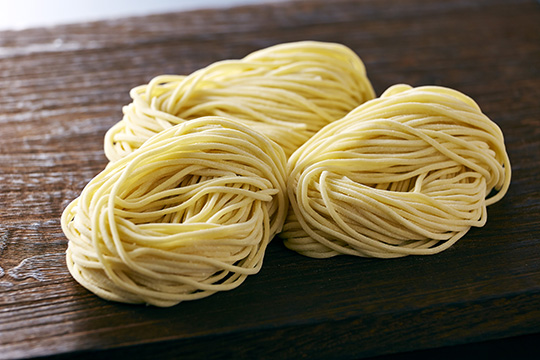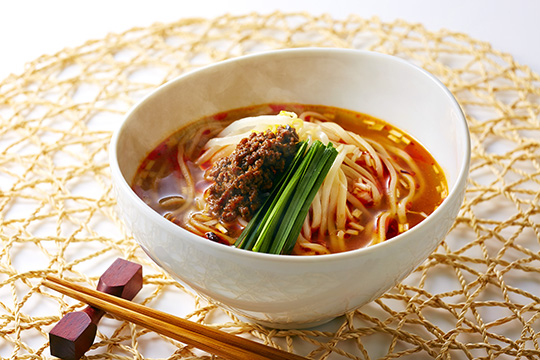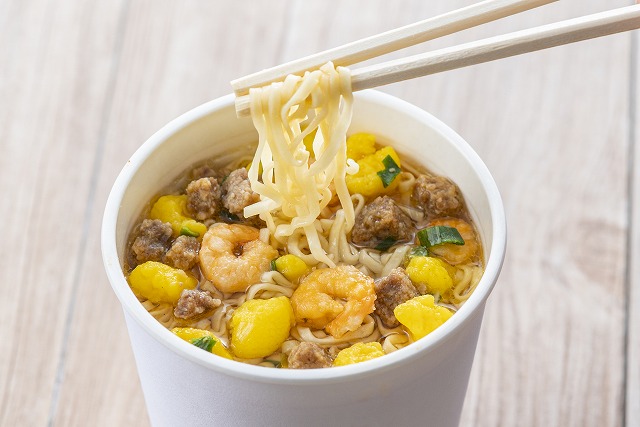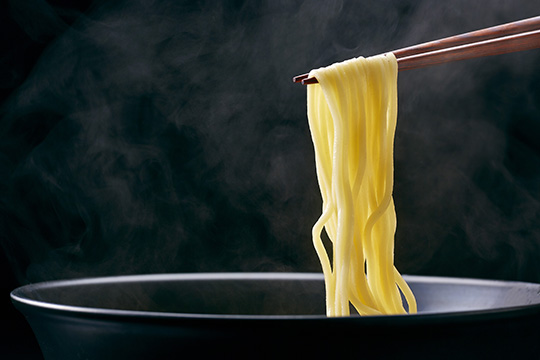News & Blogs
In this blog, we touch on diverse topics about Japanese food cultures, practices together with the culinary secret, TREHA®, and its important role in the Japanese food industry. We hope our blog helps you obtain in-depth knowledge of Japanese cuisine and the science behind it, which is hard to find elsewhere.
The five elements of ramen explained: The standard recipe is non-existent.
Although it has its roots in China, ramen is a noodle dish that has evolved uniquely in Japan for over 100 years. There are outrageous numbers of ramen shops all across the nation fiercely competing with one another. There is no textbook recipe for ramen because variations are infinite, through the combination of the five required elements: noodles, soup (dashi だし), seasoning sauce, fats/oils, and toppings.
Noodles:
Ramen noodles are thin, long, and made of wheat flour. Except for some special cases, ramen noodles contain alkalinized water called kansui (かん水), which adds a unique yellowish color, aroma, and texture to the noodles. This is the most significant feature of making ramen noodles unique from udon or soba, which are other forms of comfort food for Japanese people.
Noodle manufacturers make several styles of ramen noodles such as wavy, straight, and hand-massaged to obtain irregular textures (temomi 手もみ). Ramen shops choose the ones that complement the taste of ramen soup, a combination of soup stock and seasoning sauce, they proudly create on their own.
Soup stock (dashi だし):
Soup stock is prepared using a combination of multiple different ingredients, including but not limited to meat and poultry (e.g. pork and chicken), seafood and seaweed (e.g. kelp and dried sardines), and fragrant vegetables (e.g. garlic and onions). Ramen can be classified by the type of soup stock. Typical examples are "Tonkotsu", made by boiling pork bones until the soup becomes milky white, "Chicken Baitang", a chicken version of tonkotsu soup, and "Creamy Rich Seafood" made with a significant variety and amount of seafood.
Ramen shops keep soup stock in a large stockpot simmering and ready for customers. Salt is barely added to the soup stock to prevent it from becoming too salty as water evaporates while simmering. Seasoning sauce, prepared separately with salt content, is mixed with the soup stock upon order. Ramen shops pour their souls into their original soup stock. The preparation process could take nights and days. This is part of the reason why ramen shops in Japan stay open for long hours.
(Click here to learn more about dashi soup stock.)
Seasoning sauce:
Seasoning sauce is often flavored with basic savory seasonings such as miso, salt and soy sauce in addition to spices, vegetables, seaweed, fruits, and animal protein in the form(s) of paste, powder, and/or extract to accent the flavor. The sauce is prepared ahead of time, allowing it to be nicely blended together.
The sauce typically comes in three categories: soy sauce (shoyu 醤油), salt (shio 塩), and miso (味噌). In the same order, ramen can be classified as shoyu ramen, shio ramen, and miso ramen. The seasoning sauce is kept separately from the soup stock as it loses its aroma and changes its taste profile when heated for a long time. Ramen soup becomes complete when soup stock and seasoning sauce are mixed together just before serving.
Fats and oils:
Fats and oils of all kind made out of animals and vegetables with or without flavoring spices could be used. They are the essential ingredients to add umami to ramen.
Toppings:
Though there are no rules for the toppings, char siu, menma (fermented bamboo shoots), green onions, boiled eggs, seaweed, wood ear, bean sprouts, and spinach are the most frequently used items. In addition, wontons, butter, red pepper, minced meat, shiraga negi (thin strips of the white bottom of green onions), mitsuba (Japanese wild parsley), corn, and stewed meat are also commonly used.

Ramen showcases local delicacies
Japan, as an island, is narrow east to west and long north to south covering different climates that nurture a wide variety of raw materials. They are closely tied to local food cultures and traditional narratives behind them. Most Japanese communities have special dishes featuring such local harvests, which are called local (gotochi ご当地) specialties. Ramen, which consists of local harvests, is referred to as "gotochi ramen."
Countless gotochi ramen are seen all over the nation. The three most famous styles are:
Sapporo (札幌) ramen which emerged in Hokkaido prefecture featuring miso-based soup with a lot of local vegetables.
Family's pride (Iekei 家系) ramen first invented by the Yoshimura Family (Yoshimura-ya 吉村屋) in Yokohama city featuring pork bone soup, soy seasoning sauce, and thick and straight noodles.
Hakata (博多) ramen which was born in Fukuoka prefecture featuring milky white pork marrow soup and fine noodles. Hakata ramen is known for its flexibility in noodles, which allows a guest to order the doneness and another serve with or without additional charge.
Katsuura Tantanmen ramen (勝浦タンタンメン) introduced in the previous posting on "B-class gourmet” can also be considered "gotochi ramen".
While gotochi ramen represents a regional flavor, popular items are available through franchised shops as well as mail/online orders throughout Japan, which allows us to taste every single gotochi ramen existent.

Ultimate go-to food: instant noodles
Freshly prepared ramen tastes fantastic, but don't forget about instant ramen noodles, which were supposedly first developed by Mr. Momofuku Ando, a Taiwanese immigrant who is a founder of Nissin Foods. Instant noodles can be prepared and enjoyed anywhere we want. How time-saving! Besides, thanks to modern technology, instant noodles came even closer to the real ones.
It is no exaggeration to say that instant noodles are stocked at every household as an everyday meal as well as emergency food because it is easily prepared with boiling water or in a pan. In particular, packaged instant noodles are widely used by home chefs because they can add a creative, personal twist. As a matter of fact, instant noodle sales skyrocketed during the pandemic.

Though it has roots in China, ramen has been already registered for the hall of fame of Japanese national food for ages, which even created a sport called "ramen hunting" that engages many people in all age groups.
By the way, it is totally appropriate to slurp noodles (ramen, soba, and udon) in Japan. There are several theories behind this, which were both scientifically and leisurely tested on TV shows. When noodles are slurped, it is theorized to make ramen even tastier:
A greater amount of flavorful soup reaches the mouth with noodles when slurped.
By breathing air while chewing, the aroma circulates within nostrils that stimulates our taste buds more effectively.
Inhaling cold air with noodles prevents burns when they are very hot.
An interesting side story goes that Japanese youngsters are not good at slurping noodles because of the prevalence of western dining etiquette, which finds slurping to be a bad manner. Even the new word, "noodle harassment", abbreviated as "nu-hara" (ヌーハラ) emerged and became controversial. Don't worry, anyone can slurp after some practice.
I hope you slurp through as many bowls as possible to find your favorite ramen or create one for yourself.

Did you find this blog interesting?
Please share it with your friends in the food service industry.
We regularly update the blog about the food culture of Japan, where TREHA® was discovered for culinary applications.
Click here and send us a message to subscribe.
Or hit us up on Instagram @trehalose_sensei!

